
Donate to Innerviews
Since 1994, Innerviews has provided uncompromising, in-depth interviews with musicians across every genre imaginable. And it does that with no trackers, cookies, clickbait, or advertising.
Your donations are welcome to help continue its mission of highlighting incredible music and artists, without any commercial considerations.
Your contributions will be instantly transformed into stories and videos, and cover hosting and web management costs. Importantly, your dollars will help ensure Innerviews remains absolutely free to all visitors, independent of their ability to financially support it.
Please consider making a donation today by using the PayPal QR code below.

Bill Nelson
Every Day's an Adventure
by Anil Prasad
Copyright © 2023 Anil Prasad.
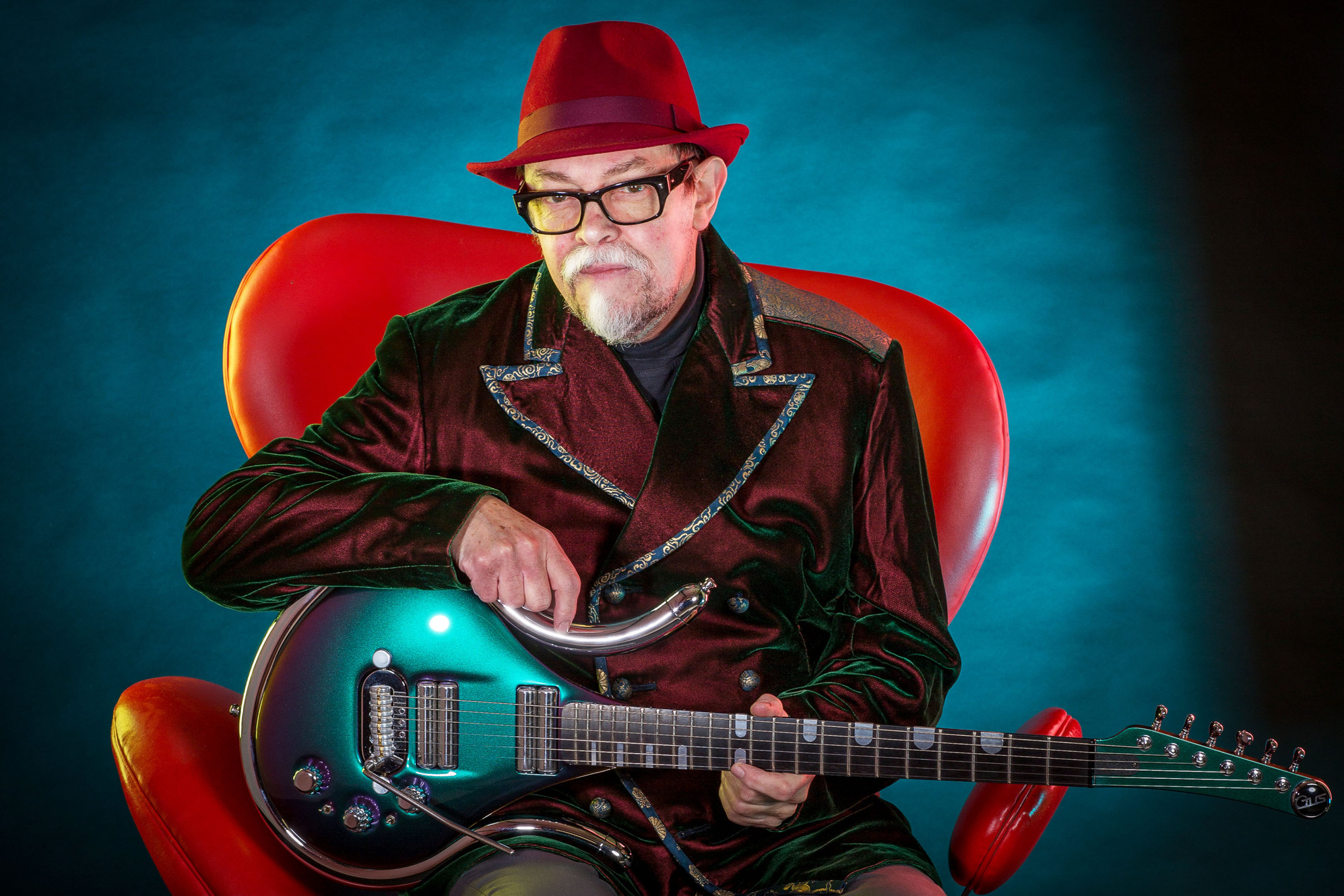 Photo: David Charles
Photo: David Charles
For Bill Nelson, the creative process and the monsoon of inspiration that informs it are perpetual. The British guitarist, singer-songwriter, and composer is one of the most prolific musicians in recorded history. He has more than 150 solo albums and EPs to his credit, another six with the expansive rock group Be-Bop Deluxe, myriad box sets and collections, and that’s before taking into account dozens of LPs in which he’s a producer or collaborator.
Beyond sheer volume, there are two critical elements that are truly impressive. The first is that the majority of his solo work is of consistently immense quality, showcasing an incredible diversity of interests across genres and styles. The second is the fact that at age 74, he shows no sign of slowing down.
Nelson’s recent output is a combination of new and notable archival material. He has two simultaneously released 2023 studio albums out titled Stupid/Serious and Marvellous Realms, which feature songs and instrumentals. The former is a collection of material with emotional contrasts reflecting its title that explores psychedelic and avant-rock realms. Nelson refers to the latter as a “meditation on time and impermanence, wonder and mystery, and magic and melancholy.” It offers some deeply personal lyrics, including several that ponder his mid-septuagenarian status, and musical directions combining contemplative rock and pop structures, with an occasional nod to the jazz realm.
While Nelson has little interest in looking back at his storied ‘70s oeuvre, his global fanbase certainly does. Nelson’s work from that period forms the basis of a robust expanded reissue campaign from Esoteric Recordings. It began with super-deluxe editions of the Be-Bop Deluxe back catalog. And it now extends to Nelson’s late-'70s Red Noise era with the release of Art/Empire/Industry, a six-disc set that brings together the entirety of the band’s efforts, including new stereo and surround remixes of its classic 1979 Sound-on-Sound LP by Stephen W Tayler, demos, and live material.
Red Noise, while ostensibly Nelson’s first solo foray after Be-Bop Deluxe disbanded in 1978, was named as an umbrella term to capture his next career phase exploring ever-changing musician lineups. It’s steeped in new wave and electronic influences of the era and captures his interest in sci-fi and dystopian concepts that go back to his childhood.
In this career-spanning conversation, Nelson explores many highlights of his 54-year journey as a professional musician, from his 1971 debut album Northern Dream, all the way through to his latest output, as well as key collaborative projects. He also offers a preview of what’s coming up in the future.
You've been more prolific than ever since the pandemic began, with seven studio albums, and a box set of another six unreleased recordings in just three years. What enables you to be so productive?
For me, it’s like when I was painting at art school. I’d just start with a blank canvas and it was about the joy of making marks and just seeing where they lead. Every day's an adventure in that sense. But it's difficult, I think, for an artist to completely nail down what it is that inspires them or makes them create work. Creativity is an inherent thing that I think people are born with. And I'm lucky enough to have the space and the time to be able to explore the different avenues that I'm interested in, musically.
In a sense, the pandemic didn't change anything because I've always been like this. I record every day in my studio. I'm 74 now and music's one of the few pleasures I have. The truth is, I really enjoy the recording process much more than playing live. I've given up playing live because of health issues anyway.
Now, while the pandemic didn’t change my recording habits, it did give me an opportunity to put together a lot of stuff I already had in the archive. As you said, I put six albums together into a box set and got them out of the way. It came out as My Private Cosmos.
I'd built up this archive of new and old tracks. I thought that title gave me the opportunity to pull some of these things together that are diverse in styles, but maybe not strictly in the mainstream. It really was a private world I was creating within that.
It seemed like a big task to sort it out into the six albums, and determine which track goes where. It was a very long process. And then I worked on the package ideas and images. Looking back on it now, all of that seemed to take more time than any of the music took. But it got done. Once I got a copy of the finished set, I went through it to make sure it looked good. And then I put it on the shelf, and it’s never been looked at again.
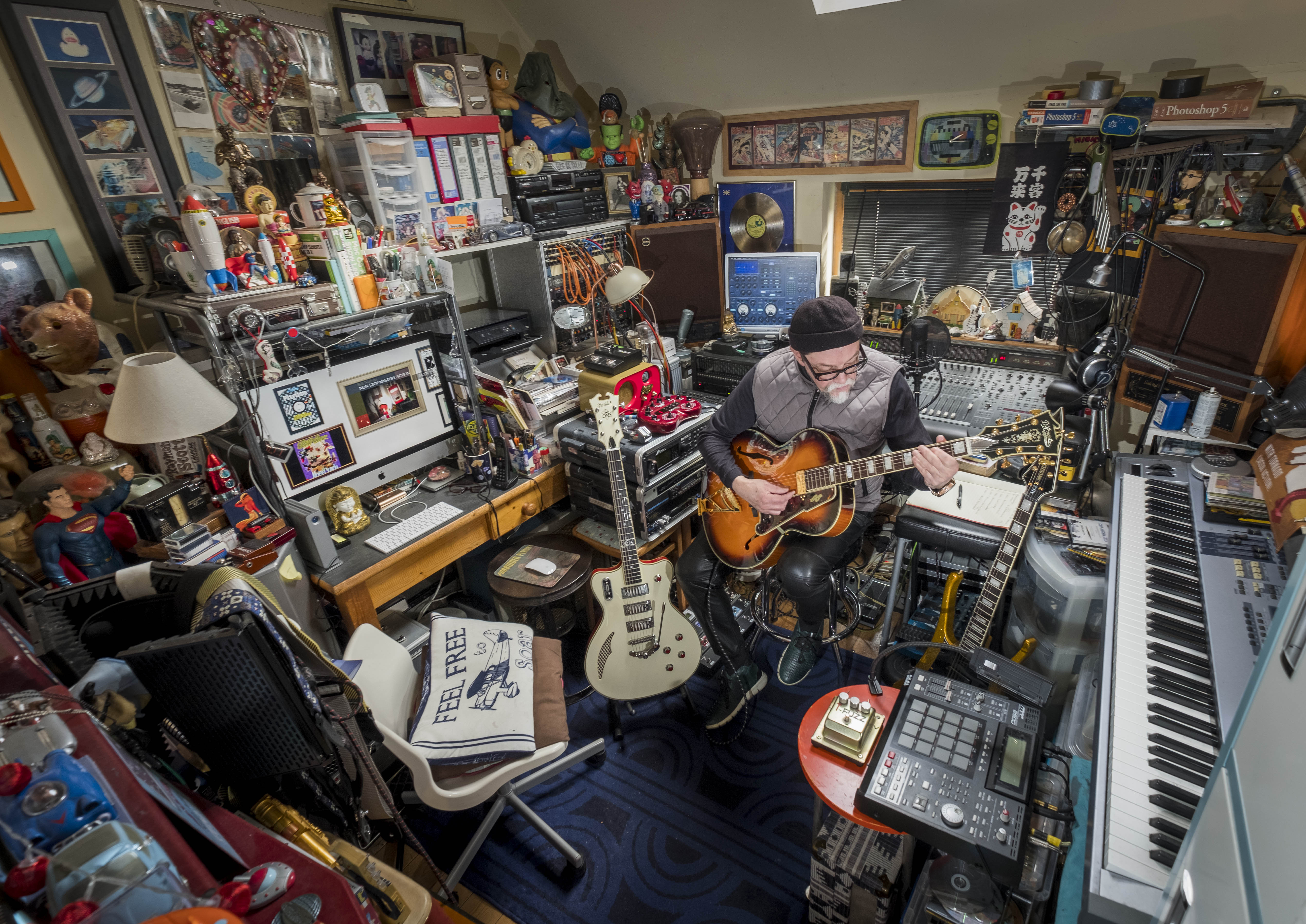 Bill Nelson at work in his home studio | Photo: Martin Bostock
Bill Nelson at work in his home studio | Photo: Martin Bostock
Provide some insight into your creative process.
Sometimes there are specific things I want to try and get down in a certain way. One of the albums I did a few years back was called The Alchemical Adventures of Sailor Bill. I wanted to make an album about my younger days, with reminiscences of the coastline of England, particularly the northeast coastline, where I spent a lot of time with my parents when I was a kid. And I wanted to try and capture that atmosphere. So, the whole album was themed around that idea. And the songs were specifically created to convey my feelings about the coast of the UK. So, the album came together with a plan. Other times, I have no plan at all. I just find something that sounds or feels right, whether that be a drum program or a keyboard or guitar sound. And I'll just lay down five minutes’ worth of whatever it is, and then see what comes up next and chop away. It's partly a painting and it's partly a sculpture. I get a block and then I chop away at it until something starts to emerge, and it looks like it might be something. And then I end up often in a totally different place from where I started. The actual meaning doesn't become apparent until sometime later when I come back and listen to it and realize what that’s about. It's a subconscious thing that's come out. And it starts to make more literal sense rather than abstract sense.
How do you initially capture ideas?
It often starts with percussion and drums, and maybe just a keyboard pad. It's rather like having an empty room and then you lay down a carpet and then you start to bring in bits of furniture. Then you start decorating it with pictures on the walls and objects around the room. It's a musical version of that. In a way, it doesn't matter what I start with. I just need something to kick the thing off. And often that first thing I take away when I’m further down the line.
Some musicians can take months, years, or even decades to complete a song or album. What enables you to move from creation to conclusion so quickly?
Well, I suppose it's because I've been doing this for so many years. I do have an actual process and it relates to mastering a recording system, whatever it might be. I changed to a more software-based system a couple of years back. Before that, I was using a hardware system. It took a little while to get used to the software system. At that point, things became a lot slower. I almost wished I hadn't gone down that route because I felt it was a quicker process with the hardware system.
But once I did finally get my head around how to operate the software system, things became much faster. I'm not anti-technology by any means, but I don't like the technology to get in the way of the creative and musical process. So, the less obstruction there is from the technology, the better it is for me, and the faster I can work. When I’m doing things in a spontaneous way, it's not like I’m writing a song, but rather the recording process is the creative process. I need to be able to work quickly on a whim. It's a bit like Jack Kerouac’s "First thought, best thought," approach.
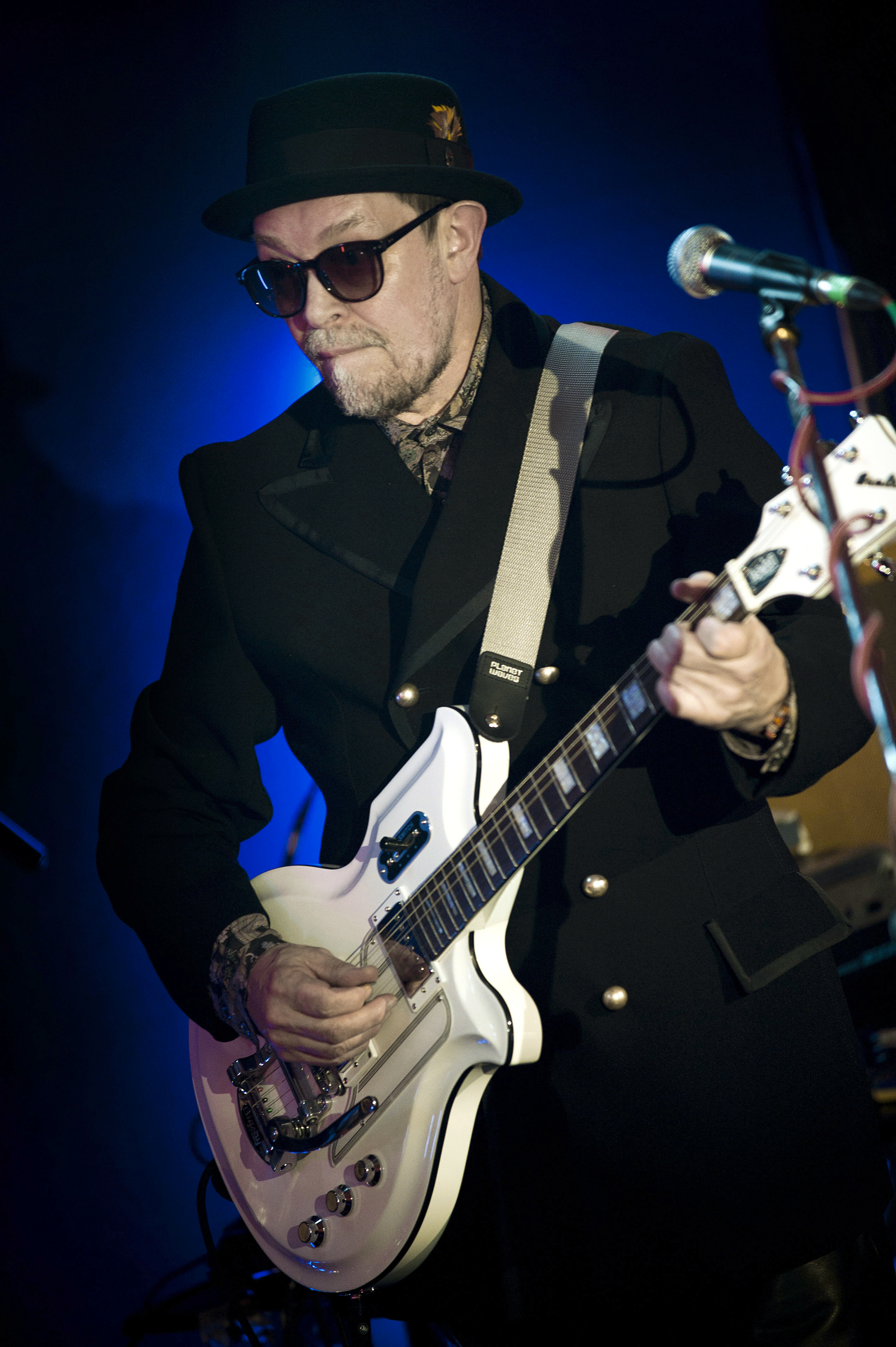 Photo: Martin Bostock
Photo: Martin Bostock
Apart from the technological component, what other challenges do you face in your creative process?
I remember someone once saying “As soon as you open the guitar case and look at the guitar, it’s challenging. It’s saying, ‘Come one, do something.’” So, that’s it in a sense. The start of every song or instrumental I record poses a challenge to a degree. But once I am inside it and working, it's a completely natural process. It doesn't take an awful lot of deliberation. It's more instinct than anything else.
I have to trust my instincts and not worry about what anybody else is going to think about it. I don't make a piece music thinking, "I wonder what fans will think about this?" All I do is make the music that I need to make at that point in time. And then when it's done, it's done. And rarely, when I put an album out do I listen to it again. I'm usually on to the next project by then. I have no interest in listening to my older stuff. In fact, when my wife puts anything on in the car or here at home that I’ve done, I either turn it off or leave the room.
You have two new albums out: Stupid/Serious and Marvellous Realms. What do they represent for you within your lineage of solo recordings?
Stupid/Serious I recorded in 2016. I have a number of albums recorded between that period and 2020, which I haven’t put out yet. Because of the volume of music, it takes some time for it to all come out. They’ll come out occasionally between more recently recorded music.
I usually record without thinking about how an album will take shape. I record tracks and then afterwards, I go back and work through the material and try to sort them into some semblance of a theme that allows them to hang together.
With the material on Stupid/Serious, it seemed that some of the songs were a little silly and some were a little more thoughtful. So, I thought it'd make a nice contrast between each track. Marvellous Realms, which I recorded early in 2022, is more about the melancholic and thoughtful side of things. I also have other albums coming up called All the Fun of the Fair, Starlight Stories, and Fables of the Future, which has the subtitle Echoes of the Past. I’m now working out the final running orders and putting the artwork together.
How do you feel you’ve evolved as a musician across the myriad recordings you’ve made?
I think it has always been evolving even from the first days of me making records from Northern Dream to Be-Bop Deluxe. Every Be-Bop Deluxe album was a progression. And then on from that to Red Noise and then through the solo stuff. Every album's a step, but not necessarily forward. Sometimes it’s sideways. But I don't sit down and think I'm going to do something futuristic or push the envelope. It’s just whatever comes out at that point in time. As you change as a person, so will you change as an artist. It's inevitable. Stasis is terrible thing to have in art. Standing still is no good at all.
I think the more recent work has more noise elements in it. It has glitches. And some of the technological elements come from that sort of thing. I’m trying to combine more abstract forms with more melodic forms. It's become a fusion of everything that I've ever been interested in. It's also got elements of neoclassical music, ambient music, and jazz elements. I call it a fusion, but it's not fusion music in the jazz-rock sense.
The lyrics of “Time is a Mechanism” from Stupid/Serious are intriguing. There’s a particular line that that goes “Time steals your life away.” Explore what you’re communicating.
Writing lyrics is the hardest part of the process for me. The actual music comes easy. But with the lyrics, I've written so many songs over the years. So, what do I sing about, now? The answer can take two forms. I can do absurdist lyrics that put things together that don't necessarily flow logically but seem to have a meaning. The listener will put their own interpretation into it and find their own meaning in them, and they might not necessarily mean anything other than they like the sound of the words together. And then another approach is about who and where I am in this moment in time. I’m 74, so I tend to dwell on mortal thoughts. It's realizing how fast a life goes by. When you’re younger, it stretches out ahead of you, seemingly forever. But when you get older you realize it's a very short thing indeed. And that provides something for me to get my teeth into in terms of lyrics.
The title track of Marvellous Realms feels like an existential lament for humanity’s inability to appreciate what’s real and tangible around us. What are your thoughts on it?
I've always liked the idea that we live in two worlds. We live in the waking world and the sleeping world, which is full of dreams. And that dream-like realm can translate back to the waking world. The song tries to point out that we live in these realms, and that they're equally marvellous. But I must admit that I also find the amount of time people spend staring into the screen on their phones a little disturbing. It's almost as if people aren't actually appreciating really fully what's going on around them. It’s a kind of evolution-devolution thing.
You've said the manufacturing and release process for your music is frustrating. Given the ability to put out as much music as anyone wants to online these days, why not focus on that realm for your prolific output?
I like the CD as a physical object. I like the idea of those sitting on a shelf somewhere and not being forgotten because they're physically there. I do downloads, but the thing with them is generally some people cherry pick tracks and don't get the whole album. That’s not so with my stuff because I don't allow that cherry picking. They have to buy the album. But with other music, they'll just skim through something. "Well, I like that one. I'll have that." And then it goes on their phone or some other device. And then it's forgotten after a while because it's not physically tangible. It's simply not there. It's just this thing in the air that dissolves away. And I think music deserves more respect than that. I do prefer a CD to streaming or a download. In fact, I've never downloaded or streamed any music myself. If I want to buy an album, I go out and buy it physically.
What’s your view on the current state of the music industry?
In some ways, it's the same old music industry, but just using a different method to exploit the artist. As you've heard from loads of musicians, streaming doesn't pay very much at all. And yet the streaming companies and the record companies make money from it. But the artist makes very little, unless you are a mega pop star getting tens or hundreds of millions of streams. But the record companies are still making a hell of a lot more. And so, in that respect, nothing's changed.
The thing that I do with my cottage industry in which I've released my own records is that it’s direct to the consumer. That's the way it works for me. I don't need to have that PR setup or record company advertising or anything. People find it by word of mouth. And it's a quiet way of doing things, but it does work. And if you’re not chasing fame and fortune and you just need to earn enough money to continue making music full-time, then it's a good way to do things.
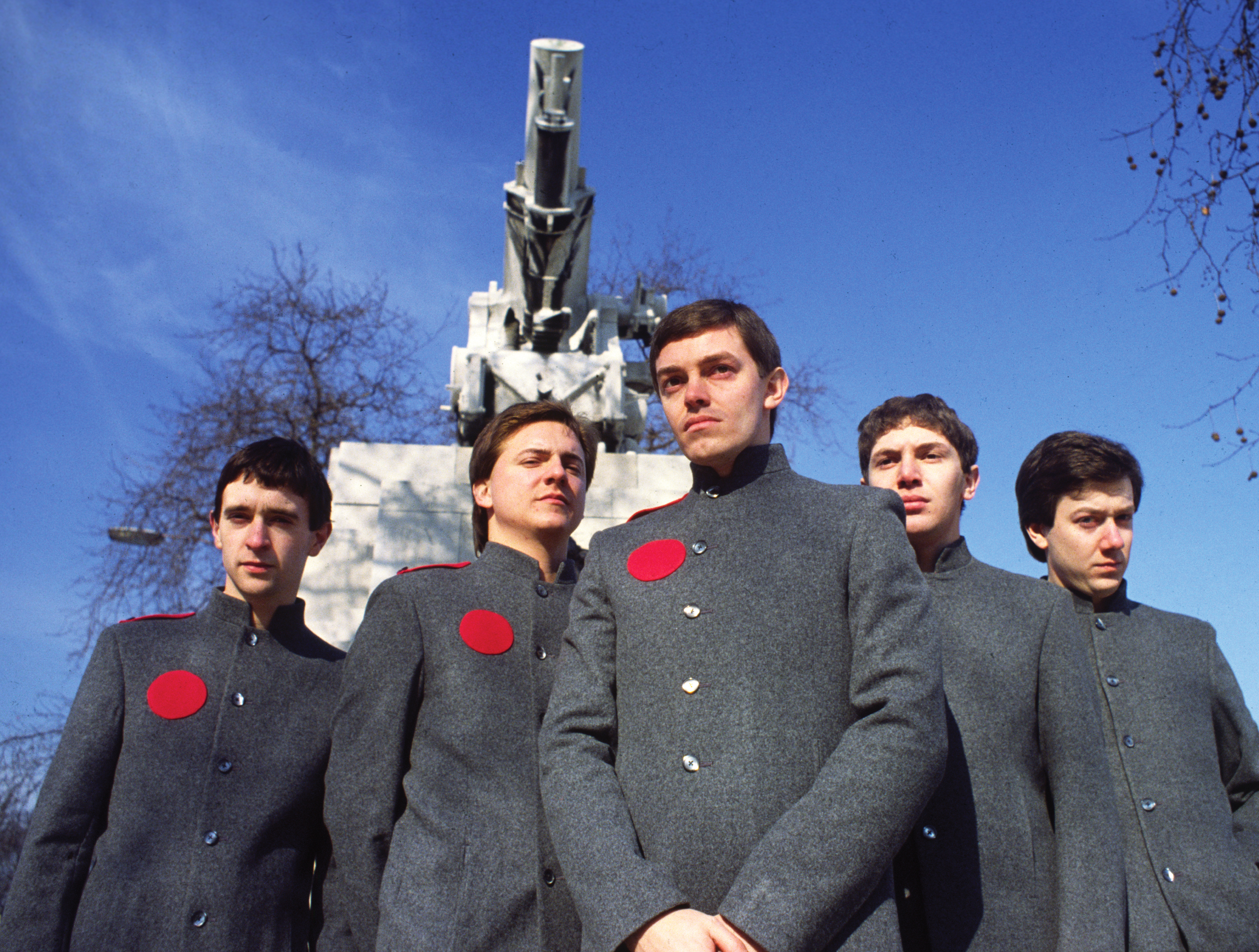 Red Noise, 1979: Ian Nelson, Andy Clark, Bill Nelson, Rick Ford, and Steve Peer | Photo: Denis O'Regan
Red Noise, 1979: Ian Nelson, Andy Clark, Bill Nelson, Rick Ford, and Steve Peer | Photo: Denis O'Regan
Tell me about the origins of Red Noise’s Sound-on-Sound.
It came about over a period of time because after Be-Bop Deluxe had recorded Modern Music, I felt that that kind of thing had come to its conclusion. I wanted to shake things up a bit and change things around. I proposed putting a new band together and doing something different. The management the band had at the time, and EMI, the record company who I was signed to, said to me "Just do one more album and then you can try this change." They wanted to get another Be-Bop Deluxe album out of me. So, I went away and did that, but I still had this feeling that it needed to be something more edgy. So, I wrote and demoed the tracks that became the Drastic Plastic album. And that was a halfway step towards what would eventually become Red Noise. After Drastic Plastic, which we toured to support, I was then allowed to split the band up and plan the Red Noise project.
The idea for Sound-on-Sound was to create a near future scenario—a sort of Orwellian thing where things were shiny, chromium, and bright, but underneath that there were some slightly sinister things going on. That basically was the first idea I had to put the album together.
Could you have imagined the dystopian elements you examined on that album would become everyday occurrences in modern society decades later?
It’s true. It's weird to consider. Obviously when it was recorded, the world was a different place than it is today. Some of it does seem prophetic. But it’s a mystery how that happened.
There’s a science fiction theme across many of your albums. Tell me about your interest in that world.
Well, when I was a kid, from about five years old, I was into science fiction. My father used to bring home several British comic papers on the weekend, and one was called The Eagle Comic, and it had a cartoon strip created and drawn and by a man called Frank Hampson, who was a fantastic artist. it was called Dan Dare: Pilot of the Future. I used to read these stories every week. So, it started with that.
We’re in the early ‘50s, when I was a child growing up. The main game children played would be Cowboys and Indians. They also watched The Roy Rogers Show and Hopalong Cassidy on TV. So, for Christmas they'd get cowboy outfits, guns, and holsters. But I wanted a space suit. There actually was a Dan Dare space suit you could get. And my parents bought one for me and a ray gun that had a multi-colored beam of light. It was like a torch, but it was in the shape of a ray gun.
As a kid, there also used to be matinees at the local cinema on Saturday mornings. My parents would drop me off for an hour there and I’d watch those old Flash Gordon and King of the Rocket Men serials. I think the idea of exploring other worlds I’m intrigued by was influenced by that.
Later on, as I got older, I started reading more literary science fiction books, such as those by Ray Bradbury.
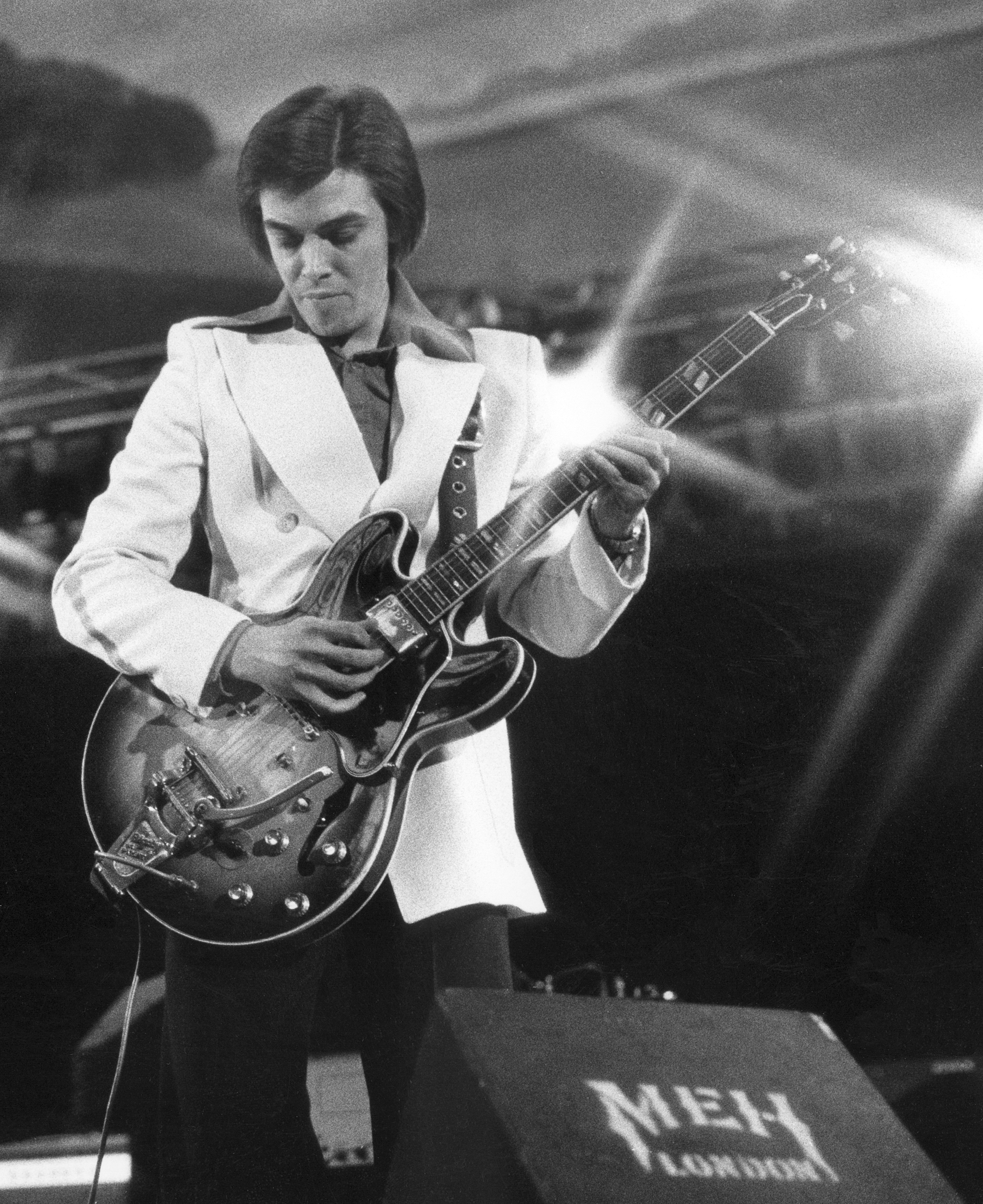 Bill Nelson performs with Be-Bop Deluxe, 1975 | Photo: Harvest Records
Bill Nelson performs with Be-Bop Deluxe, 1975 | Photo: Harvest Records
I understand Be-Bop Deluxe’s record labels at the time were less than receptive to Sound-on-Sound. Describe what transpired.
Red Noise originally wasn't meant to be a fixed lineup. The idea was that Red Noise could be either me on my own or with other musicians, but the other musicians wouldn't necessarily be permanent fixtures. I thought it would be nice to change things around a bit and keep moving. I had been listening to a lot of electronic music since the early ‘70s when Kraftwerk first emerged—before they were famous. When I was a teenager at art school, I was also interested in avant-garde music, John Cage, The Fluxus Movement, and so on. It seemed to me that it was going to be interesting to bring some of that into a pop-rock format.
Red Noise was also about me trying to not get trapped by the guitar hero tag, which seemed to have emerged at that time, through Be-Bop Deluxe.
The record company in America was Capitol Records. They'd been putting the Be-Bop Deluxe stuff out and were very happy with its success. When they heard I'd changed things, they said, "Well, can we listen to the album before we decide what we're going to do with it?" So, the album was sent to them. And what they did was they put it out around to dozens of radio stations in America to get feedback and see how people would react to it. The DJs had to fill in a form saying what they thought—whether this was going to be something they could play or not.
When the answers came back, Capitol sent me a copy of them, and they were hilarious. They were so negative. They were saying, "What is this shit? Has he gone crazy?" [laughs] All this kind of stuff. So, Capitol wouldn't put it out.
And then in the UK, EMI were taken over by a company called Thorn Electrical Industries, and they put new management into the record company. From then on, it seemed to be being run by accountants rather than A&R men and they decided they would only continue with big-selling artists like Kate Bush, and they dropped all the bands that were really interesting. I got the push, along with Red Noise. I suddenly found myself without a record deal.
How did you recover from the situation?
The first thing was to try and go down the independent route and start my own label, which is what I'd done with Northern Dream, the first album that got me the deal with EMI. So, I started Cocteau Records.
By this time, I'd actually recorded what was to be the follow-up album to the Red Noise LP. I took one of the tracks from that session, which was a song called “Do You Dream in Colour” and that became the first single on Cocteau Records in 1980. Funnily enough, it got airplay and looked like it could have become a bigger success if we could have had more copies pressed. But because it was a small self-made label, we didn't have the funds to keep pressing up copies for the demand. We only pressed a certain number that we thought we would sell.
The follow-up record to Sound-on-Sound was called Quit Dreaming and Get on the Beam, and EMI still had the rights to it, so it sat on the shelf for 18 months. Then I met a man called David Bates, who was an A&R man for Phonogram. I was in the studio producing another band, and Bates was with one of his bands and came across to see me. He said, "Why haven't you got an album out?" I said, "Well, I've finished one, but EMI won't release it." He replied, "Can you send me a cassette of it?" I did and he said, "We'll put it out." So, they bought the rights to the album from EMI and released it on the Mercury sub-label, and the album went top-10. That was a vindication of sorts.
What’s your perspective on the Art/Empire/Industry box set, which includes all of Red Noise’s output, as well as surround remixes?
This is going to sound strange, but I've never listened to it or any of the Be-Bop Deluxe remixes. I think I want to keep that work as a piece in time and not modernize it, clean it up, or hear it in 5.1 surround sound. It was made in the ‘70s. It was mixed the way we felt was right then. And that's how I want it to stay. But if it is messed around with, it needs to be radically changed.
There’s a guy named Steve Alexander, who went under the name Flashman, who did a mix of Be-Bop Deluxe’s “Heavenly Homes.” He stripped nearly all of the band out of it, and put on some really cool electronic drums, jazzy piano, and did things with echoes and delays. It sounds other-worldly. It’s a really creative remix that I approve of. So, unless it’s something like that, which really changes the scenario, I’d rather just leave things as they were. But I understand why Esoteric is doing these, because they’re for hardcore fans, and it’s an attractive proposition for them to have new mixes.
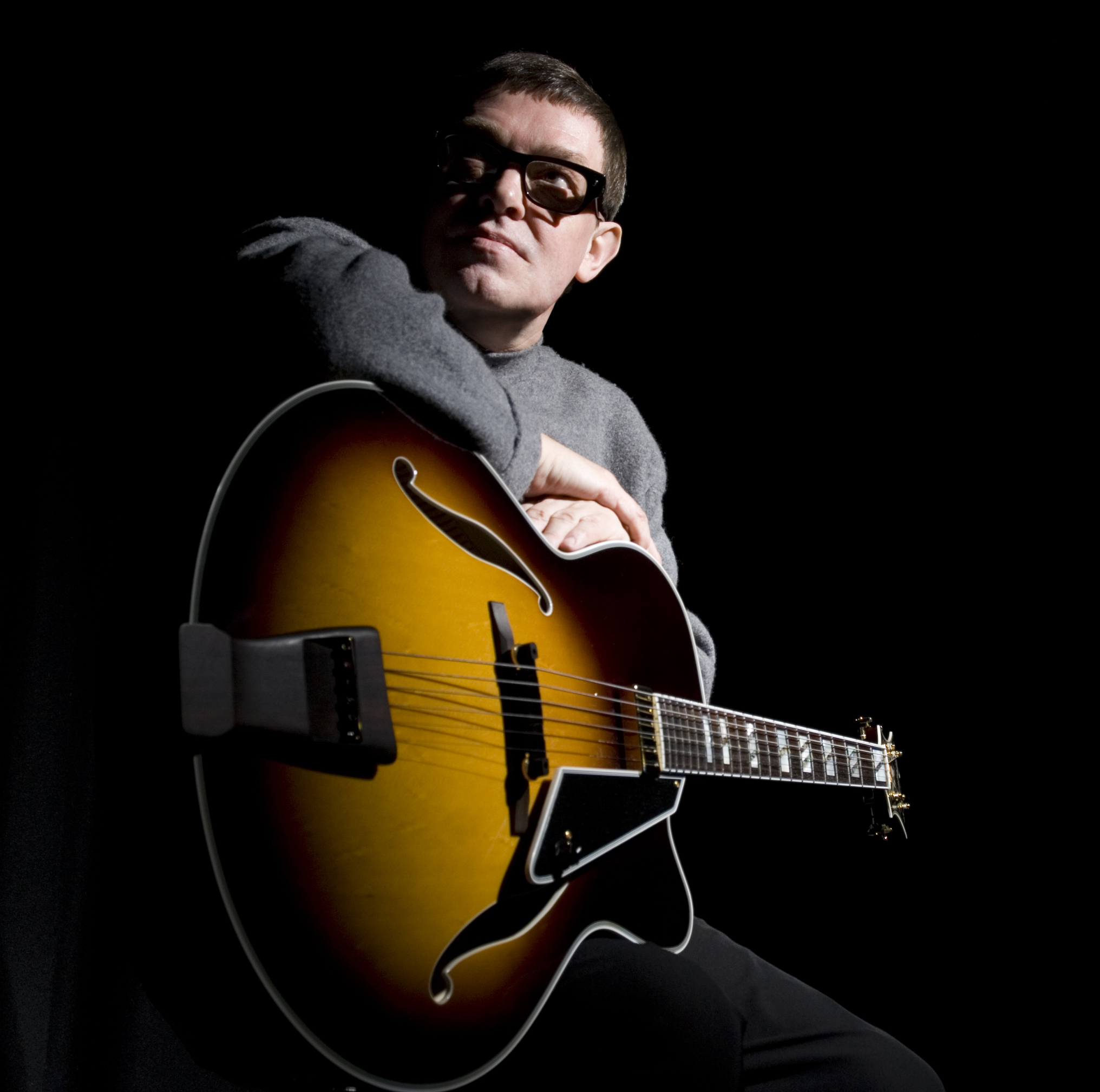 Bill Nelson, 2005 | Photo: Martin Bostock
Bill Nelson, 2005 | Photo: Martin Bostock
I’d like to name some solo recordings and albums you’ve contributed to, and have you tell me whatever comes to mind. Let’s start with Northern Dream (1971).
That was recorded at Holyground Records, the studio run by Mike Levon. He had this bedroom studio in Wakefield. I met him one day almost by accident. I ended up playing on a couple of albums they put out. One was a group of hippies in his place that made records. I got roped into playing guitar on a couple of tracks. After that, they knew me well enough to know they could work with me. So, I wrote the songs for Northern Dream. Eventually, that led to John Peel playing it on the radio. And that led to EMI getting in touch with me and wanting me to sign as a solo artist at the time.
Monsoon’s Third Eye (1982).
I remember recording at Rockfield Studios in Wales with them. Sheila Chandra was a fabulous singer and Steve Coe was her musical partner. I thought what they did was very interesting and really good. They did a version of The Beatles’ “Tomorrow Never Knows” which lent itself well to their style. That album was ahead of its time in some ways.
Yellow Magic Orchestra’s Naughty Boys (1983).
I first heard them when I was producing The Skids in Rockfield Studios. The Skids had Rusty Egan on drums and the band was plugged into various electronic things. Rusty had the self-titled album by Yellow Magic Orchestra. I was intrigued and bought more of their albums.
I was eventually lucky enough to work with them. First of all, I played with Yukihiro Takahashi on one of his solo albums. He was in London recording and got in touch with me and wanted me to play guitar on some tracks. After doing that, I got an invite to go to Japan to work with Yellow Magic Orchestra on Naughty Boys.
I worked with each member of the band separately on the album. They rarely were in the studio together. I would come in to work with Haruomi Hosono, and then Ryuichi Sakamoto would do one of his songs, so I would come in the studio and work with him, and so on. It wasn't like the whole band sat around together. They'd work one at a time on the pieces they'd written. Each member would write a number of songs for an album. And then they'd do their overdubs individually at different times. It was an assembly process rather than an organic playing process.
I can remember an earthquake happening in the middle of a session for the album. Everybody put down their instruments and ran under tables and mixing desks. Not being used to earthquakes at all, that was quite a shock to me.
Later on, I did a tour with Yukihiro, playing guitar in his band. Eventually him and his wife Emiko divorced, and I ended up marrying her. So, Yellow Magic Orchestra had a huge impact on my life in more ways than one.
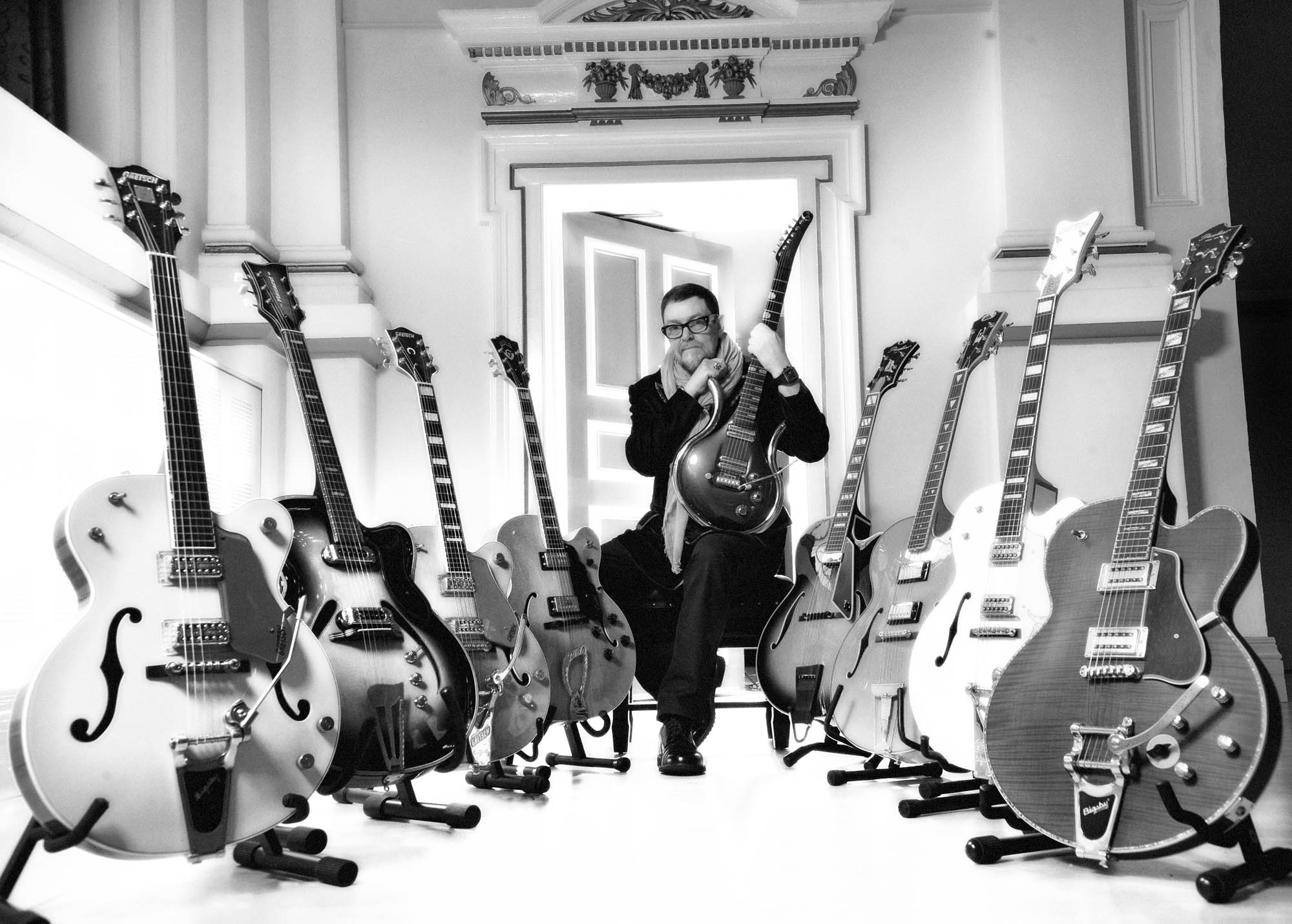 Photo: Martin Bostock
Photo: Martin Bostock
Gary Numan’s Warriors (1983).
That was a little bit of a challenge. The record company asked me to produce his album. They felt he needed to catch up a little bit. There were developments happening in electronic pop that were a little less heavy or stodgy. They wanted to brighten up his approach a little and wanted me involved to do that.
I went down to Gary's studio and worked on this album for several weeks. And then I mixed it with Gary's engineer and went back home. Next, I got a call from the engineer two days later saying, "I hate to tell you this, but Gary's gone in and remixed everything. I've quit. I'm not working with him anymore." That was a shock. I got the record company to send me copies of these mixes Gary had done, and I thought, "I'm not putting my name on that." It had come back exactly the way that he had been doing things before. It sounded like one of his older records, which is entirely his prerogative if he felt that's what he wanted.
However, I was upset that he hadn't involved himself in that project properly to say what he felt about things. So, that was it. I took my name off it, but I left my name on for the guitar parts I'd added to it. Several years later he was interviewed about it. He actually said, “I was young and didn't appreciate what Bill had done and regretted not leaving it as he’d intended it.” So, that was okay. I was happy to hear there were no hard feelings and that he acknowledged that it was because of his youth that he'd done things that way. He wished he trusted me more with it.
Chimera (1983).
At that point I was into magic in a big way. I remember doing a magical ritual each morning before I went to the studio. Yukihiro Takahashi played drums on some tracks, as did Mick Karn from Japan.
I remember picking up Mick from the railway station in Wakefield. Embarrassingly, I had a Rolls Royce Silver Shadow at the time. It’s not a car I would buy now by any means, but I had one back then. Mick said Japan had to share one beaten-up secondhand car. I was living in a nice house in the country in Yorkshire, where we had a listen to the demos I’d done. We also spent some time figuring out his parts for them and rehearsing. He did a great job and contributed really nice playing.
David Sylvian’s Gone to Earth (1986).
He was interesting to work with because he used a similar technique of not necessarily having a song written. Rather, he would go in and put something down and then invite other musicians to come and react to it.
When I played on the tracks, I had no idea how they would end up because they were incomplete. There were no vocals on them. Sometimes there was just a drum pattern and a keyboard progression, and I would just improvise on top of it. And then eventually other people were brought in, one at a time, to further improvise on top of it. David would edit it all into the final shape and then come up with the lyrics and sing on top of it.
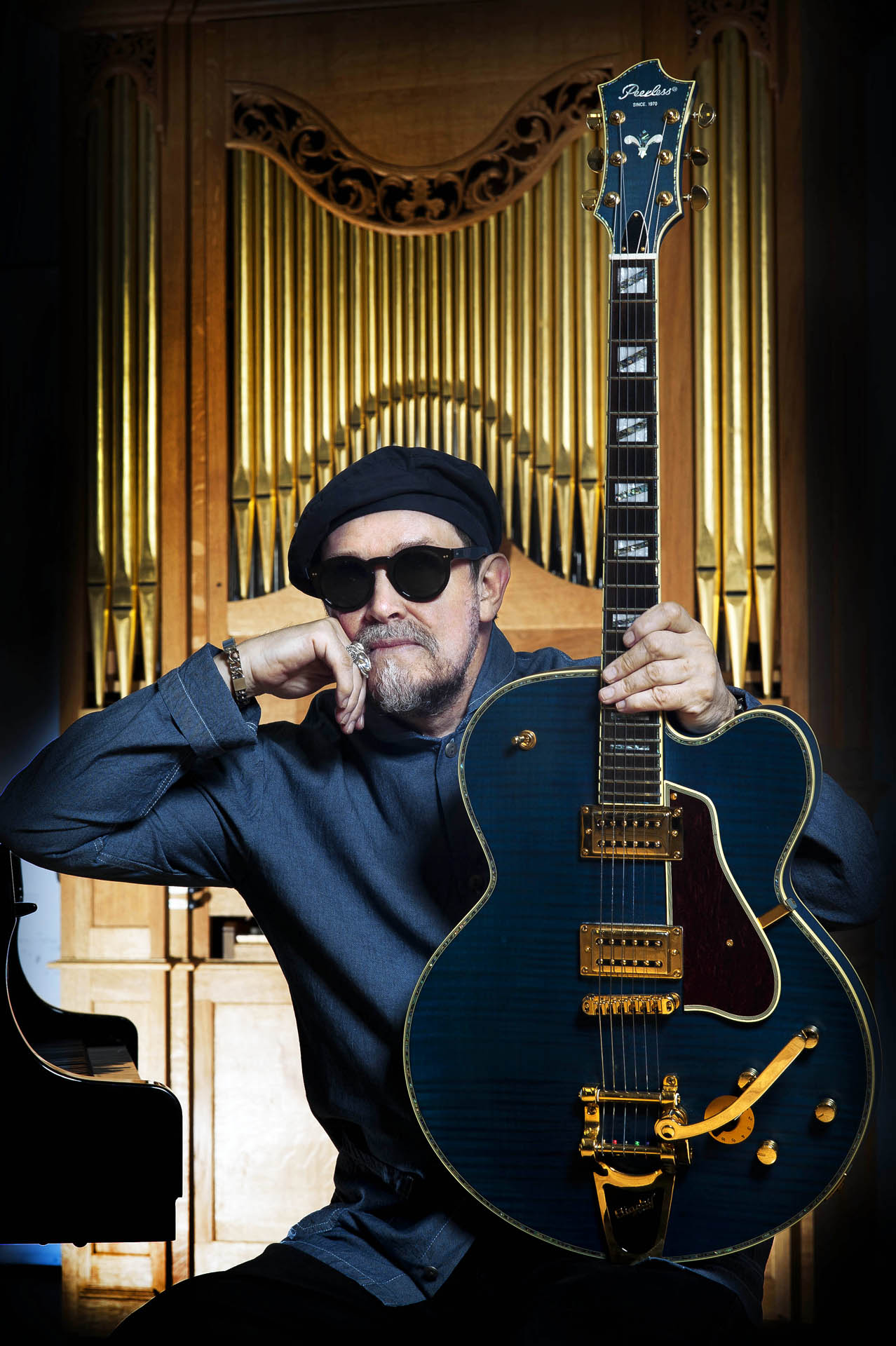 Photo: Martin Bostock
Photo: Martin Bostock
Demonstrations of Affection (1989).
It was just prior to my previous wife and I getting divorced, so a lot of the songs on that were about my emotional and mental state at that time. A lot of musicians have seemed to do divorce albums over the years. Again, it was recorded all at home. I had a studio in the house, which was bigger than the one I've got now. I've got a tiny studio now. I had room to set up drum kits and marimbas.
It was spontaneously created in that it was written and recorded at the same time. There wasn't any sort of doing demos or working out a song. It started with making a mark on a blank page and seeing where it went. The lyrics were the last thing that were added. And they were dealing with that emotional shock.
Rain Tree Crow’s self-titled album (1991).
Rain Tree Crow was basically Japan under another name, but at that time I think there seemed to be some friction between members. In fact, the project didn't go any further than the album release and the band split up once more.
I can remember recording a couple of the tracks at Eel Pie, which is Pete Townsend's studio. The pieces sounded fine to me. I can remember sitting there with my Yamaha SG guitar playing to partly finished backing tracks before vocals were added—the same process used on Gone to Earth.
Another thing I remember is I had a copy of Trial by Intimacy, my 1985 box set with me. I bumped into Pete as he was walking down a corridor. I stopped him and said who I was, and that I was working with Rain Tree Crow. I asked if I could give him the box. He thanked me and took it. Some time went by and then a letter arrived, and he said, "I can't believe I've not heard this before. It's fantastic. I really like it. Have you ever done any collaborations for a stage musical?" I wrote back to him and said, "No, I haven't. But I'm up for it if everything's good." And then I never heard from him again.
Channel Light Vessel’s Automatic (1994).
That's something I really enjoyed. I worked with Roger Eno on one of his solo albums called The Familiar from 1992. And after that, he had to do some concerts in Japan. So, a band was put together, which included Kate St. John, who also played on the album. When we got back, Dominic Norman-Taylor who ran All Saints Records, the label Roger was signed to, said "It'd be a nice thing to keep his band going, give it a name, and do something with all of you being equal." He came up with the name Channel Light Vessel, and that’s what we became, with the addition of Laraaji and Mayumi Tachibana.
We went down to Peter Gabriel’s Real World studio in Bath and started working on ideas. The album was produced by Markus Dravs, who was Brian Eno's engineer.
After we recorded it, I went off to Japan and left Markus to mix it. By this time, I’d got divorced and was living there for a year with Emiko in her apartment in Tokyo. Eventually, I got a call from Dominic saying, "I don't think we can put this out. It doesn't sound right." I replied, "Well, I've not heard the mixes. Send me a cassette of the mixes Markus has done and I'll see what I think." So, I listened to it, and I thought all it needed was remixing and a few things added to it.
I was coming back to England anyway, so Dominic said, “When you’re here, we’ll put you in the studio and see what you can do.” I suggested that we use Fairview Studios, just outside Hull in Yorkshire. I've used that studio a lot for different things. I got Kate and Roger to come up, and I did a rethink of some of the arrangements and the general sound of everything. Kate, Roger, and I also added some vocals to some pieces.
We finished the mix and sent it to Dominic to see what he thought. He said, "Great. Let's put it out." Then eventually we got to do a second album, Excellent Spirits, as well. Both of those albums are really good.
Atom Shop (1998).
It’s a space cowboy album. Some of the tracks have a sort of retro, sci-fi feel.
Those recordings are demos. I did them in the hope of putting a band together and getting Mitchell Froom to produce the album. I sent Mitchell the demos and he got in touch with me, and he said, "You don't need a producer. You just need to get a band to play some of the other parts, so there's a little bit more interaction." But I couldn't afford to hire musicians at that time.
Robert Fripp had a label called DGM and said he would put it out, so that’s where it emerged.
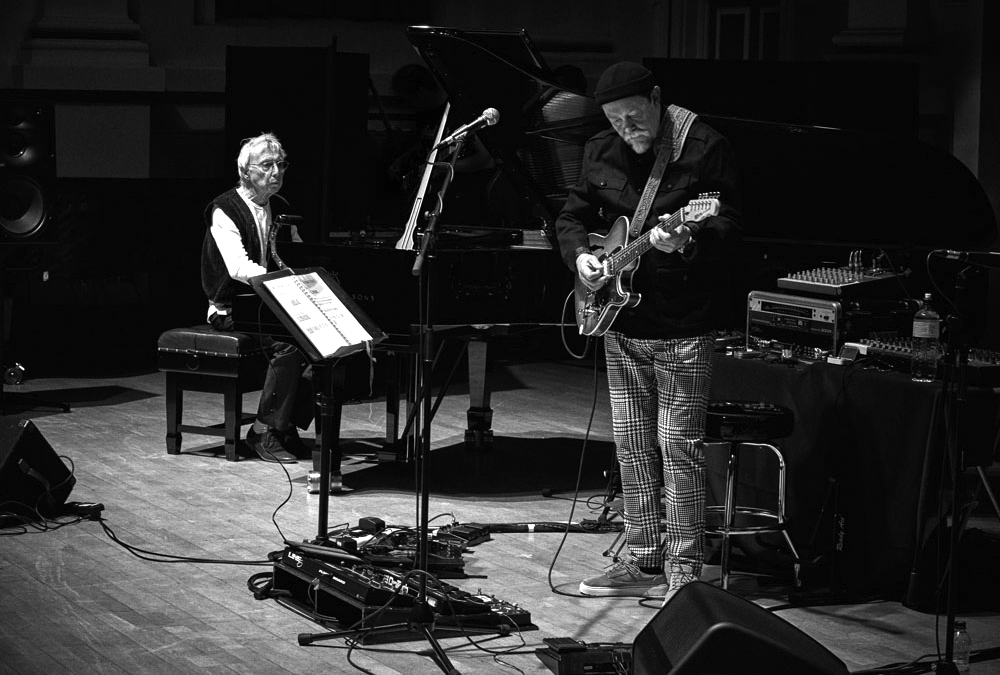 Harold Budd and Bill Nelson in concert, 2018 | Photo: Martin Bostock
Harold Budd and Bill Nelson in concert, 2018 | Photo: Martin Bostock
Three White Roses & A Budd (2002).
Harold Budd was staying with me at my place, and we went over to Steve Cobby's studio in Hull to work on it. I took a guitar with me, and Steve had my old Wurlitzer piano, the one that I actually wrote Be-Bop Deluxe’s “Ships in the Night” on. He bought it off me some years previously. So, Harold played the Wurlitzer and we improvised, and it ended up as the Three White Roses & A Budd album. Fila Brazillia also contributed to it.
Losing Harold in 2020 was hard. He was one of my really closest, dearest friends. I did a solo concert in 2018, and it was going to be my last live appearance. Harold got in touch and said, "I'm coming over. I want to see you." But he had a fall and broke his hip and things. So, he was frail, but perfectly fine mentally. I said, "No, you can't get on a plane and come over here." He said, "No, I want to. I'm going to come over." I said, "Well, if you come over, I want you to play on three numbers." He said, "Okay." He flew over and played at the show and stayed with us.
We took him and his partner, Elise, out to Castle Howard to The Hepworth Gallery in Wakefield. And then Harold got on the train to go back to get a flight back to Los Angeles, and he said, "I don't know whether I'll get a chance to get on a plane and come over again." But we stayed in touch after that, as we always did. Then I got a phone call from Elise to say that Harold had died. He'd had a stroke, got into hospital, then got into a recuperation ward to recover from it. He should have recuperated fine, but whilst in the recuperation ward he caught COVID-19 off a patient who was sharing a room with him. And within a couple of weeks, that was it, he'd gone. I was devastated. So sad. I'm missing him like mad, still. I've known him for over 30 years. He was such a really funny guy. He wasn’t at all serious as someone might think, given the type of music he created. Harold was a joy to spend time with.
New Northern Dream (2016).
That was a revisiting of Northern Dream around the time of its 50th anniversary. I wanted to do that Northern thing again—even more so than on the original album, because the original album wasn't necessarily all about northern-ness. So, New Northern Dream was a deeper exploration of the Yorkshire background kind of thing.
There’s an instrumental on it called “New Northern Dreamer” which is a new version of “Northern Dreamer” from the original album. The remake is slightly more technologically-oriented than the previous one.
It's a lighthearted album in a way. It's got plenty of orthodox kind of tunes on it, rather than anything too experimental. It was just a nice diversion to go back into that mood again.
Is there a spiritual element in your music?
There is a spiritual element and I think it’s in me as a person. It's taken many forms over the years. My first wife was a Pentecostal Christian, and I got involved in the church at that time. But at the same time, I was studying comparative religion, including Buddhism and Hinduism. I tried to introduce the idea of comparative religions and find the common denominator with the Bible classes that the church had. I was looked at as if I was the devil by mentioning that maybe some of these other religions have similar values. I drifted away from that very quickly. And then at a certain point I got involved in esoteric magical ideas and I became a Master of a Rosicrucian temple. I also got involved in Fringe Esoteric Freemasonry. After that, I sort of went back a little bit and rediscovered some of the Buddhist teachings, partly influenced by living in Japan at one point. I also had an interest in Gnostic Christianity for a while.
Now, it's hard to define what my spiritual path is. I think I eventually ploughed a very solitary path that doesn't fit anybody but myself. I don't have any definite beliefs in an afterlife. But I don't have any definite beliefs that there isn't an afterlife, either. Some days I might think there is, and some days I think, "Well, when you die, that's it. You're gone. Doesn't matter." It's a never-ending quest, just like the music. It's always posing questions that get half-answered or lead somewhere else. So, one thing leads to another. In that sense, there is a spiritual quest in some of my music.